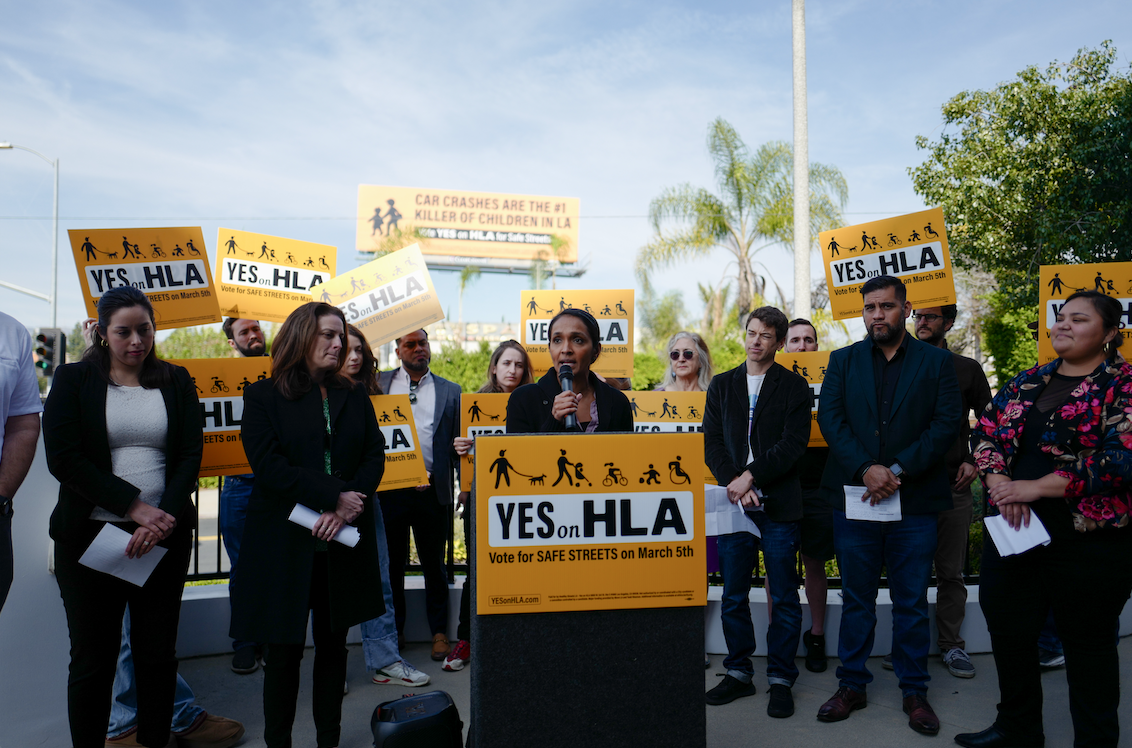Editor's note: this article is an excerpt from the Vision Zero Cities Journal and is republished with permission. For more information on the Vision Zero Cities 2024 conference, click here.
In 2024, a city known for traffic-choked freeways and narrow broken sidewalks took a step towards healthier ways to move. Two in three voters voted yes on a ballot measure called HLA; an aggressive plan to transform the streets of Los Angeles. In the coming years, many major streets in LA will have at least one traffic lane substituted for bike or bus lanes and hundreds of sidewalks and crosswalks will be improved. How did Streets for All, a five year-old-organization, loosen car culture’s grasp on its most famous poster child?
Like many other US cities, Los Angeles’ last decade of street safety is a tragic, desperate story. Traffic fatalities increased by 55 percent between 2015 and 2024. Pedestrian deaths doubled to become the highest in the nation, passing New York City despite having a population less than half the size.
The consequences of Los Angeles’s unsafe streets aren’t evenly distributed; a 2020 study from UCLA found that one in four people killed in a crash in LA was a Black or Latino pedestrian. Communities of color are disproportionately represented on the city’s high injury network — the 6 percent of streets that account for 70 percent of pedestrian deaths and severe injuries.
By the time Measure HLA went to voters, a pedestrian was being killed nearly every 36 hours in LA. More people were being killed in car crashes than homicides.
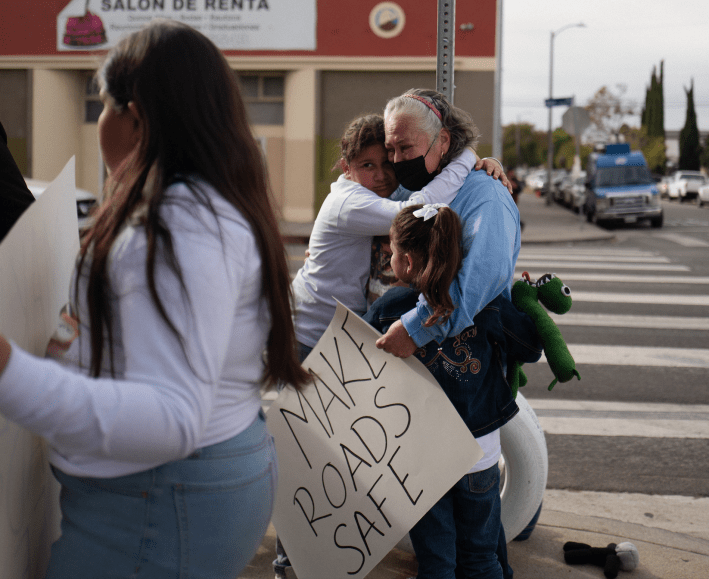
Where past efforts failed
These ideas aren’t new in Los Angeles, where two plans to build safer streets were passed nearly a decade ago. In 2015, the City created a Vision Zero Action Plan to reach zero traffic deaths in ten years. It also passed the Mobility Plan 2035, which designated specific streets for safety and mobility improvements, including specific networks for pedestrians, cyclists, transit, and drivers.
While the Mobility Plan isn’t perfect, it was a transformational vision, designating over 200 miles of streets to receive bus lanes, 400 miles for protected bike lanes, and 500 miles of improved sidewalks. It laid out entire networks of ways to move around LA reliably and safely outside of a car. However, it provided no mandate for implementation, and so, surprising few familiar with LA’s political expediency, the plan sat on a shelf.
By 2023, only 5 percent of the Mobility Plan had been implemented, meaning a 20-year plan for safe streets was on track to be finished about 150 years later.
Meanwhile, people were dying. Streets where Mobility Plan safety improvements were missing saw 56 percent of all fatal or severe crashes in 2022, despite making up only 25 percent of the city’s streets.
The reason the plan was being slow-walked isn’t complicated: it was seen as expensive, not only financially, but politically.
In 2017, after a 16-year-old girl was killed crossing the street in Playa Del Rey, a four-mile road diet was installed with safety improvements for pedestrians and cyclists. An intense backlash, including death threats to the local council member, led to improvements being torn out. (Since then, two more people have been killed on this same stretch of road). Another council member — Gil Cedillo — was so notorious for fighting road safety projects that he earned the nickname “Roadkill Gil”. Road safety projects had become political poison in Los Angeles.
Partially as a result, the City failed to invest significant dollars into safer streets. Between 2015 and 2021, the City of LA invested only $138 million into its Vision Zero program; over nearly the same time, a budget analysis showed StreetsLA and the LA Department of Transportation paid out $196 million in injury and death liability claims. The city spent more settling safe street lawsuits than building safer streets.
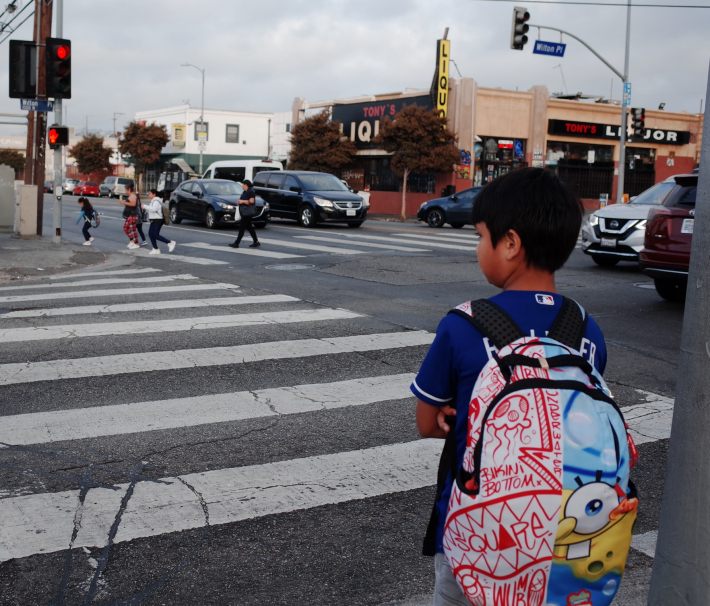
What made HLA different
Founded in 2019 as Los Angeles’s first transportation political action committee, Streets for All set out to give street safety solutions political teeth. Among other advocacy efforts, we found success during the early days of the pandemic acting as a bridge between StreetsLA (a city department responsible for repaving roads) and the LA Department of Transportation (responsible for striping roads). As a result of working with both departments to help align routine street repaving with restriping opportunities, the City installed 24 miles of protected bike lanes between 2020 and 2023. This alone increased the protected lane network in LA by 50 percent.
But those streets were a small share of the 400-plus miles repaved in LA every year without added mobility improvements. Despite our pleading with council offices to implement the Mobility Plan during repaving, we were ignored and the city was constantly re-cementing the status quo of deadly streets and limited mobility options.
We asked ourselves: what if we could tie regular street maintenance and the Mobility Plan 2035 together legally?
It wasn’t a novel concept; cities like Providence and Seattle have mandated that repaving projects follow the city’s transportation plan. It seems like common sense. But unlike LA, those directives came from the city officials. Because of the local politics of street improvements, we knew our effort would have to come from the outside to be successful.
By 2022, Streets for All had written a ballot measure and gathered more than 100,000 signatures to qualify it. Called Measure HLA, it mandated that all repaving projects over one-eighth of a mile include Mobility Plan-designated improvements. If not? Residents can sue to force compliance.
Choosing our message
We began to ask ourselves the hard question: how do you market hundreds of miles of ‘road diets’ in the car capital of the nation?
Already daunting, the odds were stacked against us. The March 2024 primary election was projected to have an exceptionally low turnout, meaning an electorate that was whiter, older, more conservative, and likely the most car-reliant demographic in the City.
We considered many messages to sell this wonky ballot measure: cleaning our air, creating more options to get around, reducing traffic, building better transit, and improving government accountability. LA Metro’s two major transit sales tax measures had chosen the traffic argument: “Get other people out of their cars so you can drive places quicker.” But when we ran polling, safety bubbled to the top of potential arguments, with more than half of Angelenos reporting feeling unsafe crossing their own streets.
Every resident of LA knows how it feels to cross the street or drive in stressful traffic, and most people know someone impacted by traffic violence. We decided all people needed to know about Measure HLA was that it would make streets safer.
With safety as our north star, pedestrians became our primary subject. While not everyone uses ‘niche’ modes like bikes or taking the bus (especially our older, whiter electorate), everyone walks. Crossing the street in LA is radicalizing. The plight of the pedestrian is immediate, understandable, and empathetic.
Our first media buy was a series of billboards along the most dangerous streets in the City. The billboards all had the same bright amber background and contained a single simple fact in bold black sans-serif:
“CAR CRASHES ARE THE #1 KILLER OF CHILDREN IN LA”
“A PEDESTRIAN IS KILLED EVERY TWO DAYS IN LA”
“29 PEDESTRIANS KILLED ON SEPULVEDA SINCE 2013”
“IN 2023, MORE PEDESTRIANS DIED ON VERMONT AVE THAN IN THE STATE OF VERMONT”
We tried over 100 different billboard designs before we found messaging and a layout that we felt was attention-grabbing and, more importantly, memorable. While taking a rideshare home from our election night party, our driver quoted one of our billboards back to me: “I saw the sign. ’46 pedestrians killed on Vermont Ave’ is unreal.”
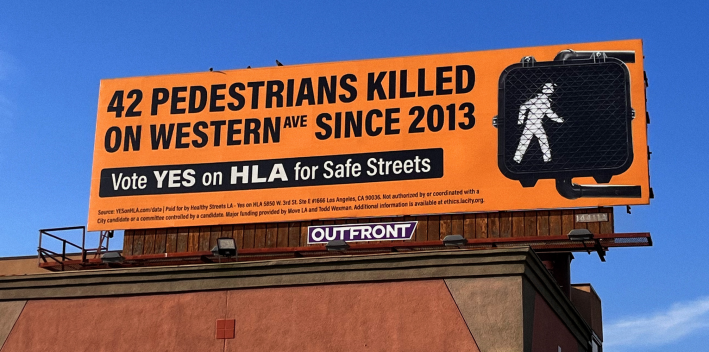
While the billboards told cold data, it felt important to make sure our campaign honored the human consequences of our streets. Each death or injury is a person, with family and friends and history. To tell these stories, we brought on a documentary filmmaker, who spent two months talking to victims of traffic violence, shooting footage of dangerous streets, and trying to capture what we felt was an accurate representation of existing on Los Angeles roads.
Hours of footage were honed into a handful of television advertisements. The most prominent profiled three women: a mother who lost her son, a school leader working near multiple deadly intersections, and a doctor who regularly treated victims of traffic violence.
We also ran an expansive digital media campaign, serving ads on Google, Instagram, and Facebook about the state of LA’s streets. Similar to our billboard campaign, some of these were geotargeted to local dangerous roads, catching people’s attention by referencing streets they live on or near.
Our campaign website was also built in-house, displaying data, maps of injuries and deaths, printable materials, and interactive maps of the Mobility Plan 2035 networks HLA would implement.
Neutralizing the opposition
While much of our marketing effort was proactive, we also had to stay defensive. We worked hard to prevent opposition spending against us and built a coalition of six City Council members, including the Chair and a majority of the Transportation Committee, major environmental groups, labor groups, and business groups.
About a month before the election, our first organized opposition emerged: the LA Firefighters’ Union. They turned our safety messaging against us, claiming that HLA would slow emergency response times and, as a result, people would die. They bought billboards and began running ads blaming fire trucks stuck in traffic on new bike lanes. They were joined by a City Councilmember using talk shows to encourage people to vote no, and the City Administrative Officer put out misleading reports about HLA costing billions of dollars.
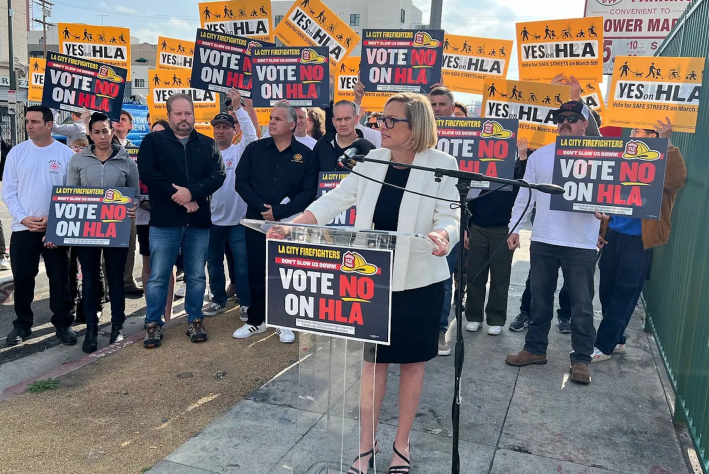
With an in-house team, we were able to work quickly to create counter-programming for social media and TV, explaining, for example, that new bus lanes and center-turn lanes allow emergency vehicles to skip traffic, and even pointing out that the City’s own environmental impact report states that implementing the Mobility Plan would improve emergency response times.
And in the end, voters listened. 65.5 percent of Angelenos voted yes on HLA, choosing safer streets instead of listening to fear-mongering. Going forward, every repaved road will require the city to install designated Mobility Plan improvements. With a focused mission and a targeted $4 million political campaign, we codified street safety improvements into LA’s $500+ million annual transportation spending. The City of LA now has a clear mandate from residents: We want bike lanes. We want safer places to walk. We want efficient bus lanes.
Los Angeles has pledged to reach zero annual traffic deaths by next year (2025). We aren’t even close — as of July, LAPD data shows that more than 160 people have already lost their lives in crashes. But one can hope we’ve hit our high water mark. The first HLA-compliant safety project, fittingly, is a 2.3-mile safety project on Hollywood Boulevard. One of the most iconic streets in the world is being reconfigured, removing half of its general travel lanes and replacing them with Mobility Plan-mandated protected bike lanes and safer crosswalks. The change is a remarkable calming of a dangerous street — and hopefully a glimpse into the future of a City that prioritizes the lives of its most vulnerable road users over car expediency.
When the world descends on Los Angeles for the 2028 Olympics, maybe it will feel noticeably different. And maybe by 2035, our streets can tell a different story: a Vision Zero success.
